Reframing the House of Dust: An Interview with Janet Sarbanes and Ken Ehrlich
by Thomas Aguila
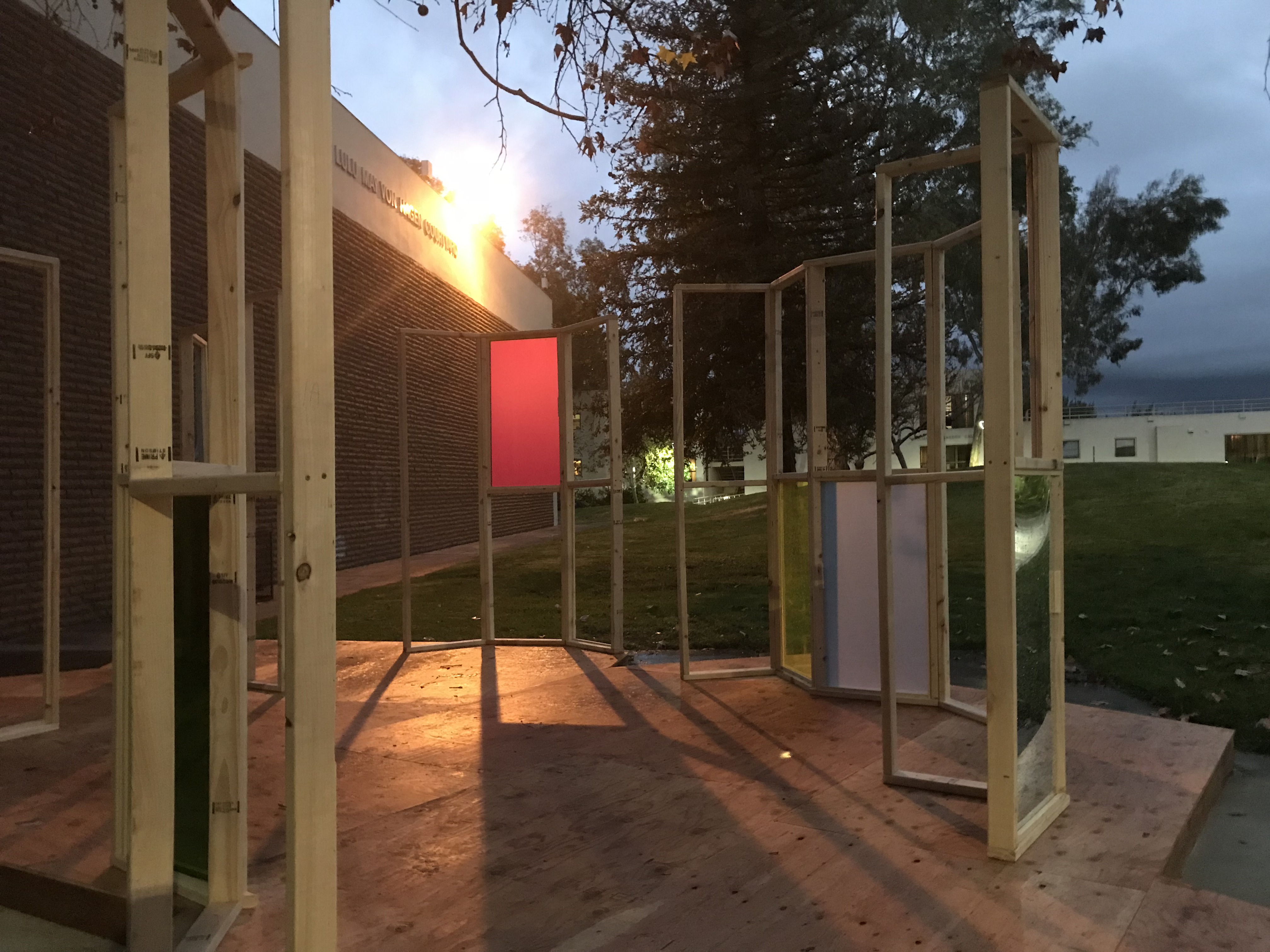
House of Glass under construction, January 2018, photo: Janet Sarbanes
The House of Dust by Fluxus artist Alison Knowles was an extensive project of many parts: a hybrid of computer-generated poetry, sculpture, happening, and pedagogical experiment. On the occasion of the fiftieth anniversary of House of Dust, writer Janet Sarbanes and artist Ken Ehrlich, both faculty members of the CalArts School of Critical Studies, alongside French curators Maud Jacquin and Sébastien Pluot of Art by Translation, organized Reframing the House of Dust. One facet of this project involved the creation of a new house—the House of Glass—designed and built on campus by CalArts students during a Wintersession workshop held in January. The House of Glass hosted a variety of community events throughout the 2018 Spring semester. A related symposium at REDCAT on March 24, 2018, featured presentations and discussions revisiting Knowles’s project and its experimental approach to technology, pedagogy, and community.
Can you tell us a little bit about the original House of Dust and how this new project, the House of Glass, emerged nearly fifty years after the original houses were built on CalArts campus? How did you both get involved?
Janet Sarbanes: House of Dust began in New York as a computer-generated poem, a collaboration between Alison and composer James Tenney. In 1968, Alison received a Guggenheim fellowship to create a structure inspired by one quatrain of the poem, which was then sited in a Chelsea housing co-op. When she was hired onto the original faculty of the California Institute of the Arts in 1969, this “house” moved with her to California and became a location for events and alternative pedagogy at the newly formed Institute. I had seen intriguing images of it in the Institute archives when I was doing research on the early history of CalArts, and I interviewed Alison about the project in 2012. 1 I had been aware of her as a Fluxus artist, but my particular point of interest was her experience as a founding member of the CalArts faculty.
Sébastien Pluot and Maud Jacquin of Art by Translation, who had curated a number of interesting responses to the House of Dust at university galleries in France, Canada, and the United States, contacted me about bringing their archival exhibition on the House of Dust to CalArts. CalArts doesn’t have a campus gallery, but I suggested the possibility of working with students to erect a new structure that would serve a similar purpose to the original. In January, I solicited Ken’s participation in the project, and together with Maud and Sébastien, we designed a Wintersession workshop introducing students to the original project and asking them to design and build a new “house,” a material translation of a different quatrain of the original poem.
Ken Ehrlich: The pedagogical dimension of the project really appealed to me. Janet and I share an interest in the relationship between pedagogy and the expanded arts that I think in part grows out of our time spent teaching at CalArts. I was also drawn to thinking about this work now because of my interests in architecture, algorithms, and networks. Considering a poem that was generated by a computer program 50 years ago, and translating that into an architectural form, seemed like a way to reflect on the myriad ways algorithms shape contemporary life in more complex and fundamental ways.
JS: In many ways, I also saw this re-engagement with Alison’s project on the occasion of its 50th anniversary as an opportunity to reactivate some of the formative principles of CalArts on or around the Institute’s own anniversary. In particular, there’s always a need on campus for space—and time—for the cross-pollination among the arts, for which CalArts is known, to actually occur; a space that belongs to no one and everyone.
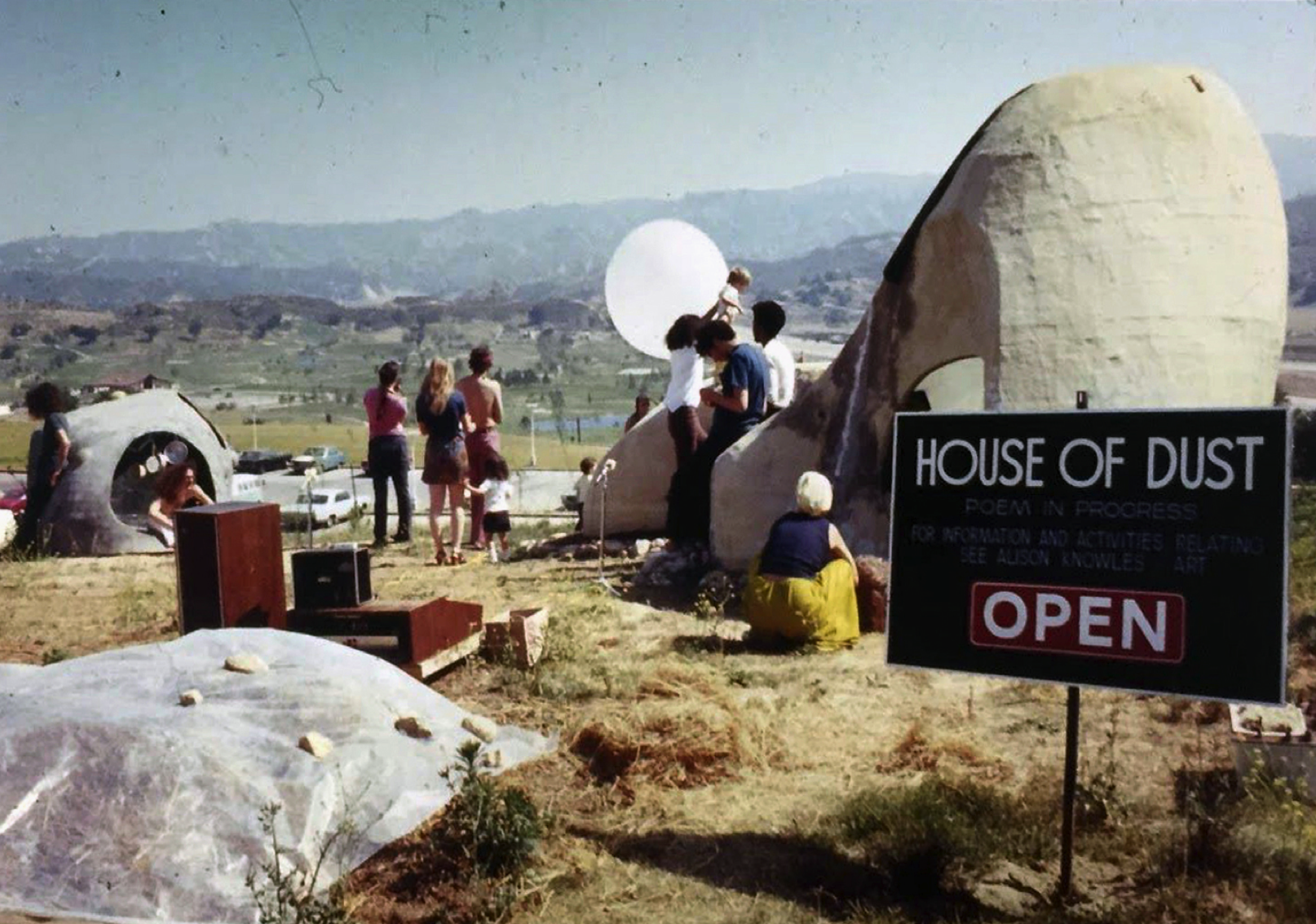
Gathering at the House of Dust, 1970, California Institute of the Arts
The first house was destroyed in New York, then relocated to California, and two more were commissioned on the CalArts campus after Knowles became a professor there. Your project, House of Glass, is the fourth house constructed from the poem. How important have the concepts of iteration and reincarnation been to the decades-long House of Dust project?
JS: Alison always expected that her own structures would be changed via activations—that the House of Dust would transform into other kinds of houses through its uses and adaptations, bringing to mind other stanzas of the poem. There is this back-and-forth between poem and material that’s really open-ended and generative. I see the House of Glass as one of these activations, but inasmuch as it translates a quatrain into a whole other structure, it could also be said to reincarnate—put new flesh on—the original idea.
The early history of the House of Dust was fractious and interesting. Maud and Sébastien, as well as art historian Nicole Woods, have done important research on this.2 The first iteration in New York, at the Penn South Housing Co-Op, which was funded by the International Ladies Garment Workers Union, was rejected by the inhabitants for a variety of reasons—it didn’t read as public art, it attracted visitors from outside the community, it was perceived as unsightly—and this resulted in the arson of one of the two components of that house.
When Alison had it restored and moved to CalArts, she shifted the “score” from the original quatrain (A house of plastic/In a metropolis/Using natural light/Inhabited by people from all walks of life) to the “House of Dust” stanza (A house of dust/On open ground/Using natural light/Inhabited by friends and enemies), which perhaps builds on this difficult experience with the co-op, describing its inhabitants as both “friends and enemies.” So you have two iterations and a reincarnation right there.
KE: The score is an enduring part of the Fluxus legacy, borrowed from musical composition, and it usually consists of written instructions that can be performed in a variety of contexts. As Janet mentions, the stanza from the computer-generated poem that Knowles used to create the original structure was, in a sense, a score. So we thought of this iteration of the project very much in relation to event scores and the possibility of interpreting the event score in ways that exceed the parameters set out in the original. In theory, many more versions of the House could be constructed.
Is this what inspired you to have the students build a house based on another quatrain?
KE: It was important to us to distinguish between reactivating the House of Dust and remaking it. Using a different quatrain of the poem was part of our strategy to develop a new iteration of the earlier project rather than create a replica of the original house. We actually had the students write an event score to determine which quatrain each group would use to generate a design for the house. This seemed like a way for us to get around an overly deterministic framework for the students.
JS: Some students had questions about this choice—wouldn’t it inevitably produce something derivative or imitative? Why go back to the printout of the original computer-generated poem rather than coding and generating our own poem, with all the digital technology at our disposal today? We could’ve gone that way, and could certainly see that as another activation of the House of Dust; but with this project, we wanted to stimulate an engagement across time with Alison’s work and the history of CalArts, and also the history of digital technology and its relationship to the arts. I was interested in how this fifty-year-old artifact could de-familiarize the digital landscape and challenge our technological determinism. Then you’re in a more interesting place to do something with the technology we have now.
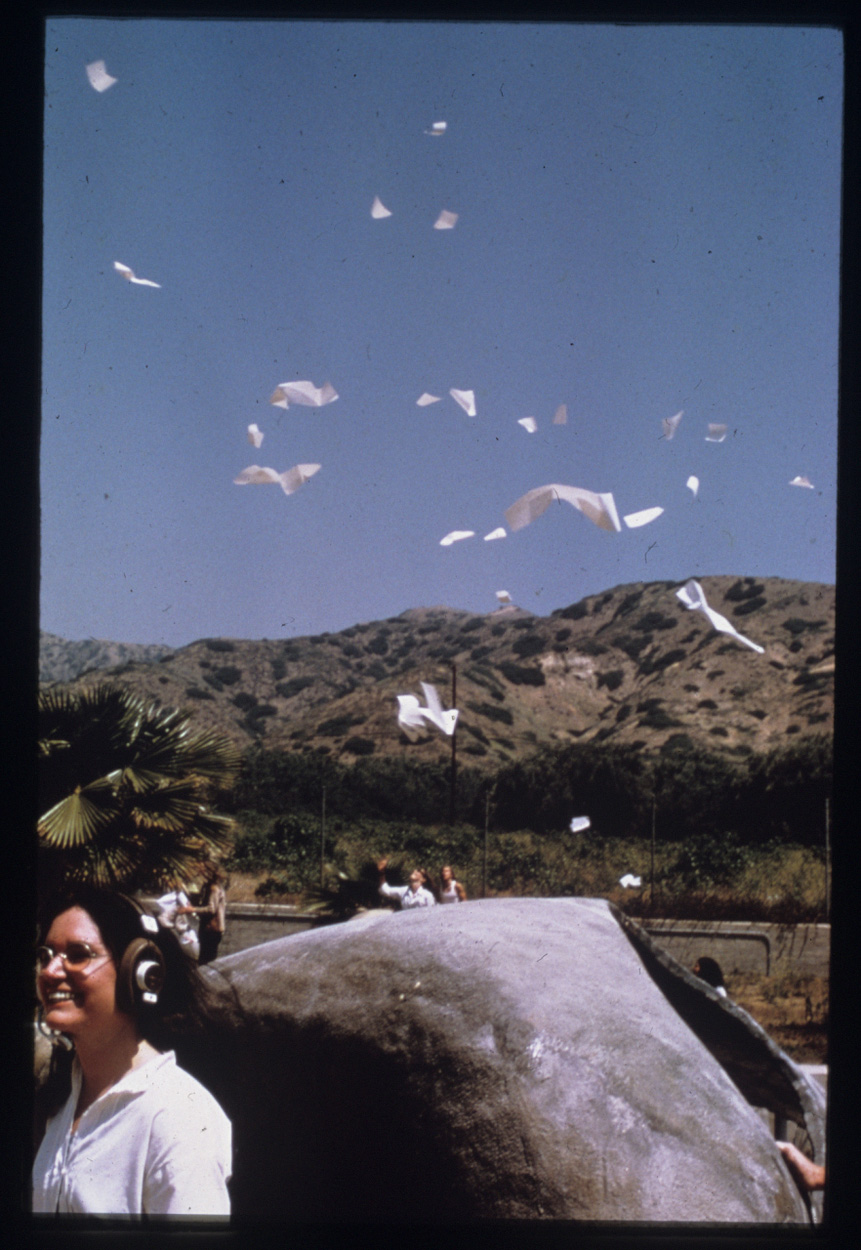
Alison Knowles with Norman Kaplan, Poem Drop Event, May 1971, House of Dust, 1969–75, California Institute of the Arts, Valencia, CA, destroyed, photographer unknown © Alison Knowles
KE: Fifty years after one of the first computer-generated poems, research on machine learning and artificial intelligence continues apace. There’s so much to think about in relation to House of Dust: notions of translation—the translation from poetry to architecture and, by extension, from language to object; the legacy and potential of computer-generated artworks; and finally, a very expansive sense of what performativity looks like and how forms of engagement with audiences have evolved since the time of the original work.
Let’s talk a little bit about the Wintersession course and the process that led to the construction of the House of Glass. What did that look like, in terms of how you worked with the students?
KE: The class had a very ambitious agenda for an eight-day workshop. One of the challenges we faced was that the contextualization, design, and building process each could have taken up the entire workshop, so there was a productive sense of pressure to address each of these areas meaningfully. We used a design process that was inspired by conversations with architect Mathias Heyden, with whom I’ve collaborated in the past. The idea was to create three groups and cycle the design ideas through each group, so every student would engage with all of the designs under consideration. We wanted to get away from the idea of a competition with a winning design and instead employ a design process that benefitted from everyone’s participation. Among the things we encouraged students to think about was how the structure might invite transformations from members of the CalArts community over the course of the semester. It’s a very challenging but intriguing prospect to develop a structure as a sort of invitation.
JS: We asked the workshop participants to think about what this structure could do on campus to activate the present-day CalArts community of artists, and also how it might re-activate the history of the House of Dust and the Fluxus legacy at CalArts. The stanza of the poem from which the House of Glass derives was: A house of glass/On an island/Using all available lighting/Inhabited by various collectors of all types. We talked about building a structure corresponding to these words and images that might activate transparency and communication among all the different populations on campus and encourage people to “collect” in different ways, to come together and also to share their interests. What resulted was this pavilion-like collection of wooden frames filled with colored Plexiglas, something between a stage and an enclosure. I’m not sure how it comes across in the pictures, but it’s a pretty magical space to inhabit.
The poem itself is quite lyrical in the way it exhausts the innumerable ways a house can be constructed, positioned, lit, and inhabited.
JS: I think it has a remarkable beauty to it, and a power that derives from the elements Alison devised: each quatrain describes a house made out of certain materials, located in a certain spot, lit by a certain kind of lighting, and populated by certain inhabitants—basically, a recipe for gorgeous images with profound existentialist, and often absurdist, overtones. It continuously unravels our notions of what a house is, and who might live there.
KE: I agree with you that sections of the poem have really lyrical qualities and this might be part of the reason the piece sparks our interest in this particular moment. Lyricism is often thought of as a measure of human creativity, so what do we make of it here?
Given that the idea was to translate a section of the poem into an architectural structure, part of the design process involved working to push abstract ideas into a material form. This required the students to negotiate between language and architecture, underscoring how conceptions of space are already somehow registered in linguistic structures.
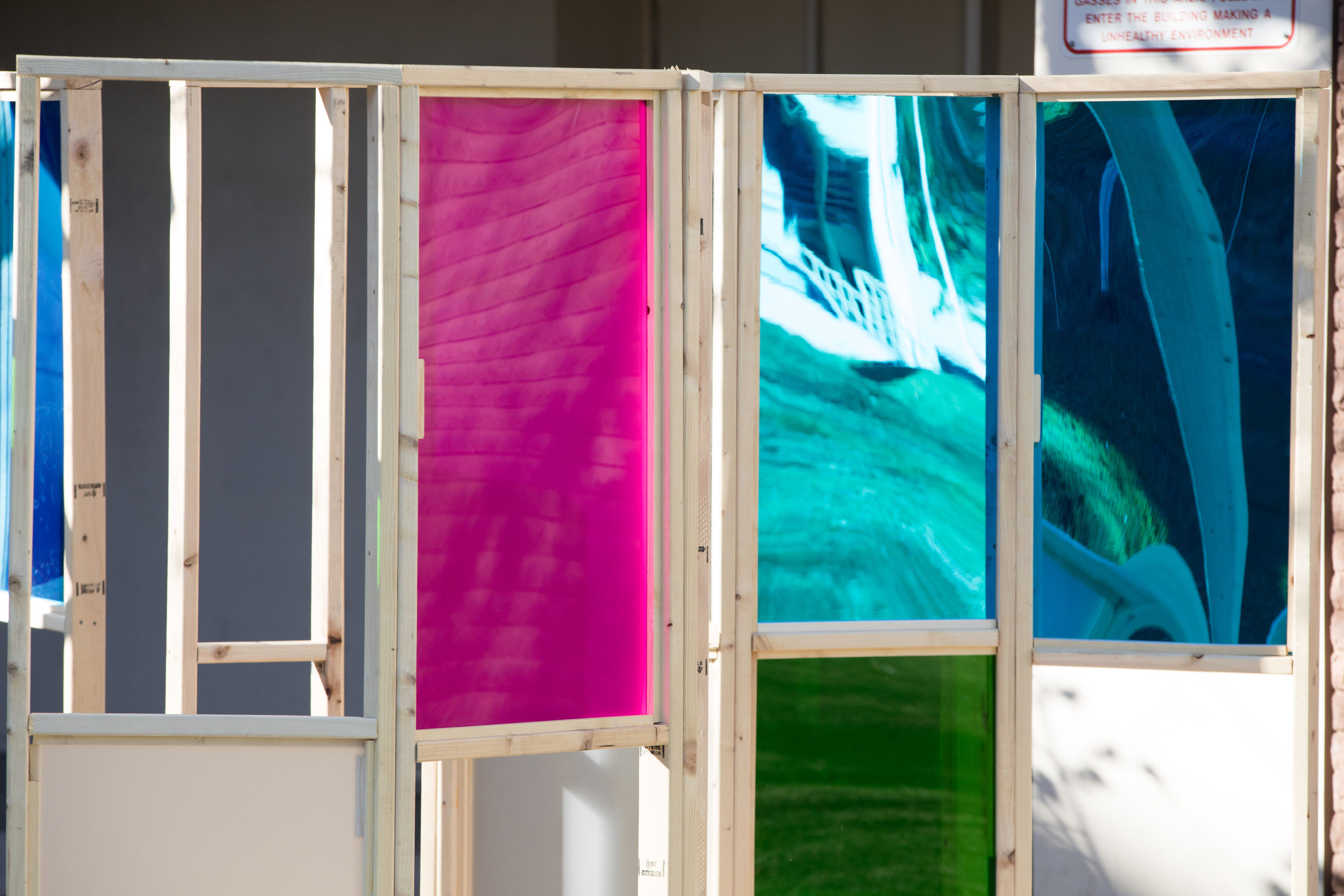
House of Glass, 2018 (detail)
At one point during this process, your class had the opportunity to speak with Knowles. How did that conversation influence or inform the construction of the House of Glass?
KE: The students presented three “work-in-progress” designs, based on three different quatrains of the poem, to Alison via Skype. They were excited to share the work with her and I think were genuinely interested in her reactions and feedback. Her response was overwhelmingly positive and, in classic Fluxus form, she suggested we build them all. Alison’s enthusiasm really helped propel the project forward. Each of the proposals had real strengths and it was a challenge to decide which design to build. Eventually, we made the decision to move forward with the House of Glass based on the quality of the design and the feasibility of our group building it over the four remaining class periods.
JS: Alison’s generosity towards the projects reinforced the openness of the score for all of us—that there wasn’t a wrong answer, there was just the wonder of these ideas and possibilities that had been generated through the process she’d initiated.
How did the collaboration with the students work in terms of the construction?
KE: The construction process, like the design, relied on small groups tasked with creating parts of the larger whole. We had teams working on the base structure, wall units, and glass installation. For many of the students, this was their first time doing construction of this type so there was a considerable amount of instruction in the building phase.
JS: I was one of those people for whom it was their first time building anything; and to be honest, I was doing a lot of organizing so I only hammered in a few nails here and there and drilled some screws. But still—I’d never done that before! Being pushed out of my wheelhouse, so to speak, collaborating with a group of artists who were all out of their wheelhouses, forced the kind of “de-skilling” or “de-professionalization” that’s necessary for intermedia projects and art practices to develop and thrive.
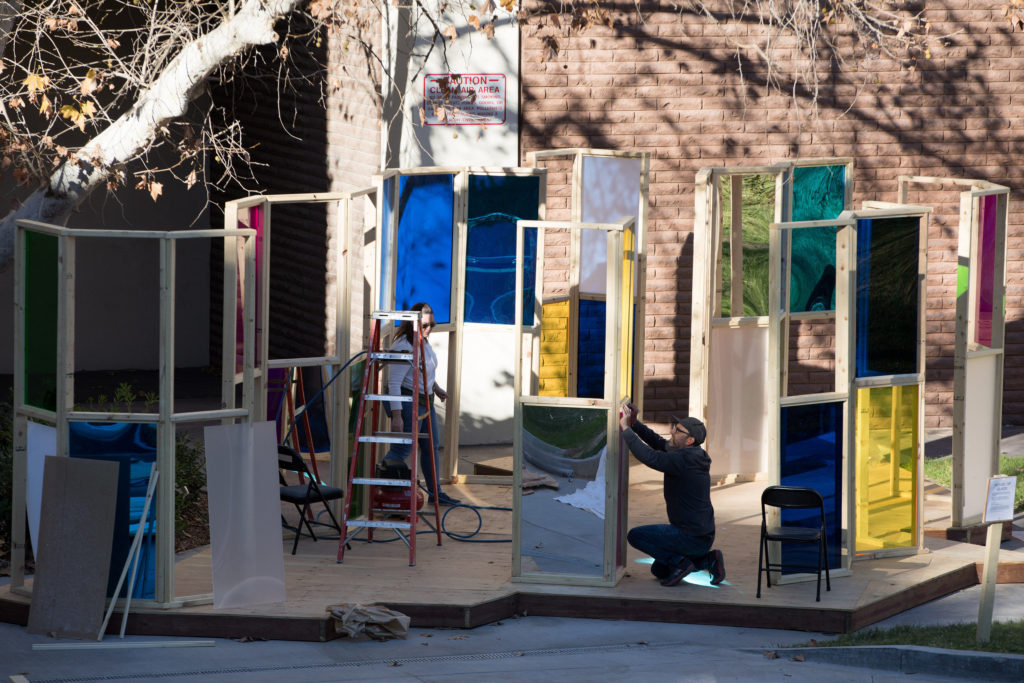
Ken Ehrlich puts finishing touches on the House of Glass, January 2018, photo: Rafael Hernandez
That seems appropriate for CalArts.
JS: Absolutely. This was a strong feature of CalArts pedagogy at the very beginning, and that’s something we discussed with the students. The original faculty included numerous Fluxus artists in the various schools: Alison Knowles and Allan Kaprow (proto-Fluxist) in Art, James Tenney in Music, Nam June Paik in Film, Dick Higgins and Emmett Williams in Critical Studies; and for them, the emphasis was really on the spaces between the arts and what could be discovered there. So for instance, Higgins offered a course in publishing, but he also offered a course in picking mushrooms. Of course in this situation, there’s a leveling of hierarchy between teacher and student, and I talk about that concept a lot. But given the more school-like structuring of the Institute these days, I don’t often have the chance to experience it the way I did during Wintersession.
In the design phase of the workshop, I felt that my role was mostly to provide context and encourage the students to ask good questions on the way to their final design, and in the building phase, they taught me what they learned from Ken and each other. This resulted in a lot of bent nails and some distress to Ken’s tools but also a real sense of accomplishment when the house finally went up. I should also mention that the majority of students in the workshop were cis women or gender-fluid persons who’d never hammered or sawed before, so there were aspects of the project that recalled Womanhouse, another famous pedagogical experiment at the beginning of CalArts. And the intensity of the process—the stakes of it, that this thing had to get built, and we had to build it—sort of liquified the usual pedagogical structures, though we remained bound by the three-hour time slot, which was kind of nuts.

Pain Spa performance collective’s “House of Lust” installation at the House of Glass, March 2018, photo: Janet Sarbanes
In interviews, Knowles has said how it is essential for the houses and their sites to be activated by the community. Can you tell us about the activations that have happened since the House of Glass opened?
JS: We had a great day at the house on March 23—five hours of performances by current CalArts faculty and students and participants in the Art by Translation program as well as French artists curated by Maud, Sébastien, and Anna Milone of FLAX [France-Los Angeles Exchange]. CalArts students interpreted historic Fluxus scores by Alison Knowles and another original CalArts faculty member, Nam June Paik [Braid, Shuffle, and Dragging Suite], and a recent score by Félicia Atkinson [A Dance, A House, A Poem]. Faculty member Sara Robert’s Readers Chorus performed a version of the House of Dust poem, and Michael Pisaro and his students played Swell Piece for Alison Knowles by James Tenney.
Alison herself attended and took part in the Newspaper Music event, conducting ten CalArts students reading newspapers in ten different languages—an absurd yet moving display of internationalism in these benighted MAGA times. She mentioned to me how nice it was to have these activations take place in and around the House of Glass, a structure built according to Fluxus principles, rather than in the more generic places her scores are usually performed nowadays: theaters and classrooms. And also how amazing the students were; which they have been, all along.
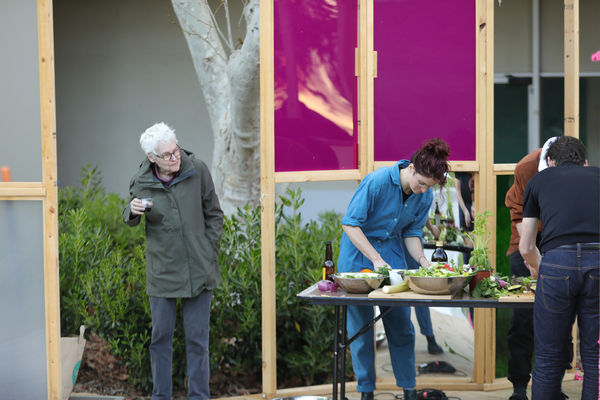
Alison Knowles observes a performance of her Make a Salad score in the House of Glass, March 2018, photo: Rafael Hernandez
And there was a symposium the next day at REDCAT ?
JS: It was a daylong symposium presented by the CalArts Aesthetics & Politics program in collaboration with Art by Translation and the MAK Center for Art and Architecture. It activated the House of Glass in a different way, providing an extremely generative lens through which to view Alison’s oeuvre, Fluxus history, radical pedagogy, feminism, public art, and the relationships among poetry, early cybernetics, and architecture.3
Why is activation such an important concept to these projects?
KE: Experimental compositional structures and performance are at the heart of Alison’s work, and this project is no different. The activation of the house is really how the work is completed. Part of how we conceived of the project was that the entire CalArts community would be invited to activate the structure throughout the entire semester. In this way, although the term “house” is associated with a very specific architecture, the work ended up functioning more like a social sculpture.
Having said that, given the housing crisis in Los Angeles and the direct connections between art, the “creative class,” and real estate speculation more generally, we also hoped the House of Glass would become a site that engaged critically with questions of actual housing. So we were very glad that [CalArts School of Art faculty member] Ines Schaber decided to teach a seminar on housing there this semester, and that her students installed their final show in the House with work that tackled these thorny dynamics.
Did the students use it for their own events, too, or were most of the activations faculty-led?
JS: Activations were an everyday occurrence at the House of Glass, both in a formalized way, by participants reserving space on the calendar, and incidentally or anonymously by students using it to rehearse scenes, shoot video, eat lunch. I’m told there was a dance party out there with a light show, and that sometimes a student brings his amp and guitar and shreds in the house in the middle of the night. And there was the day my Fluxus class discovered someone had woven hot pink thread throughout the whole structure and scattered seed all over the floor—a House of Birds. We performed historical Fluxus scores while navigating in and around this web.

Gosia Wojas leads a collective reading of the House of Dust poem in the House of Glass on International Women’s Day, March 2018, photo: Rafael Hernandez
A few other highlights to mention: On International Women’s Day, Gosia Wojas, one of the students who helped build the house during Wintersession, scored a collective reading of the House of Dust poem—a different kind of “house work.” GUNS ARE OVER! IF YOU WANT IT posters inspired by Ono and Lennon’s WAR IS OVER! IF YOU WANT IT poster were hung on the house the day students all over the country walked out of school to protest gun violence. A durational performance collective called Pain Spa renamed it “House of Lust” for the afternoon, collecting love letters and kisses from passersby. Ani Tatintsyan made a Virtual Reality film partially filmed in it, which she demonstrated as part of the CalArts digital arts Expo. Iris Sidikman held her final show (Altered States) there, and Dawn Givens installed Sky Piece nearby. An art collective made it the locus of their “Outdoor Museum.” Ines’s Photo/Media class on the housing question held a great group show there—I learned a lot about the history of public housing and affordable housing in Southern California. And numerous other faculty—Ken, Michael Pisaro, Maureen Selwood, and Rebecca Baron among them—used the house for classes and events this semester. Guest speakers and performers in the house included architect Rachel Allen and Alok Vaid-Menon. River Stastny held a Queer Babes Screaming screening there, and Lucia Salas curated a Wednesday night screening series of Latin American film organized around the theme of houses and housing during summer session.
KE: Participation and activation are ambiguous concepts. The Fluxus experiments fifty years ago that aimed at democratizing art-making practices obviously didn’t succeed in radically reshaping the rarefied place of contemporary art in our society, but there is still a certain charge to these ideas, particularly in an educational context.
JS: I’d like to think this project helped pass that spark from one generation of experimental artists to another. Who knows when and how it might catch fire?